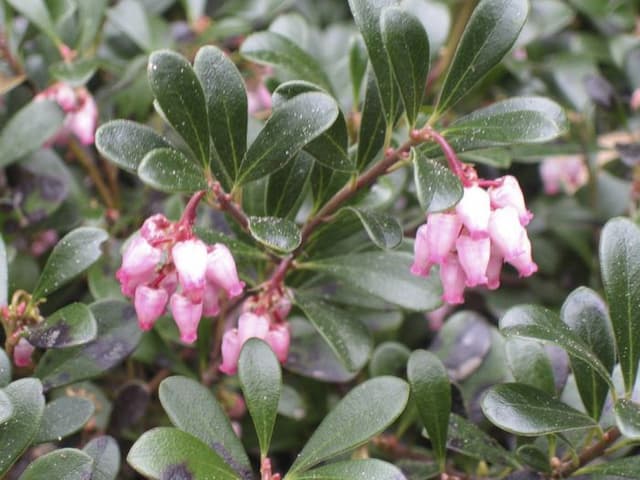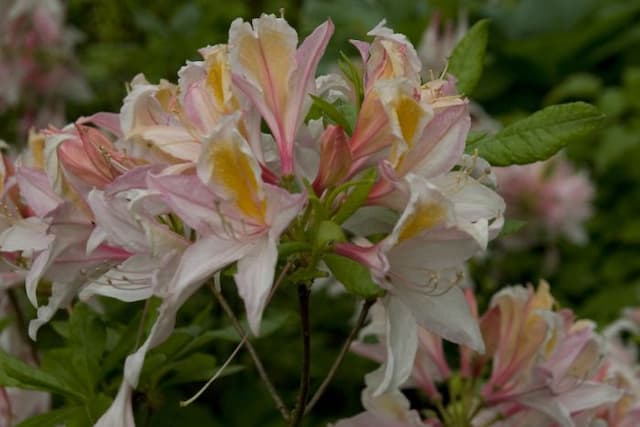Spring Heath Erica carnea 'Walter Reisert'

ABOUT
The Erica carnea 'Walter Reisert' is a captivating plant, commonly known as the Winter Heath. It boasts a rich tapestry of foliage and flowers that create a lively display in the garden. The foliage itself is needle-like and evergreen, presenting a lush backdrop of deep green hues that persist throughout the year. This provides a stark contrast to the vibrant flowers that burst into bloom. The flowers of the Winter Heath are particularly striking, emerging in dense clusters at the tips of the branches. They are a radiant pink color, sometimes with deeper shades or a hint of magenta that catch the eye and add warmth to the cool tones of winter and early spring landscapes. The Winter Heath has a compact and mounding growth habit, spreading outwards to create a full and rounded appearance that is both neat and appealing. This charming plant is treasured for bringing color to the garden during the colder months when most other plants are dormant, and for its ability to thrive in a variety of garden settings.
About this plant
 Names
NamesFamily
Ericaceae
Synonyms
Winter Heath, Alpine Heath, Spring Heath, Snow Heath
Common names
Erica carnea 'Walter Reisert'
 Toxicity
ToxicityTo humans
Winter heath is not commonly known to be toxic to humans. However, as with any plant material, individual reactions can vary, and it is generally advisable to avoid eating ornamental plants due to the potential for stomach upset or allergic reactions.
To pets
Winter heath is not widely recognized as a toxic plant to pets. Nonetheless, ingestion of non-food plants by animals can lead to gastrointestinal irritation, vomiting, or diarrhea. Close monitoring for any signs of distress is recommended if a pet consumes this plant.
 Characteristics
CharacteristicsLife cycle
Perennials
Foliage type
Evergreen
Color of leaves
Green
Flower color
Pink
Height
1 foot (30 cm)
Spread
1 foot 4 inches (40 cm)
Plant type
Shrub
Hardiness zones
5
Native area
Europe
Benefits
 General Benefits
General Benefits- Winter Interest: Erica carnea 'Winter Heath' flowers in late winter when most plants are dormant, adding color to the garden in the coldest months.
- Drought Tolerance: Once established, Winter Heath is relatively drought tolerant, making it suitable for xeriscaping and low-water gardens.
- Attracts Pollinators: Early blooming flowers provide a valuable nectar source for pollinators such as bees when few other plants are in flower.
- Low Maintenance: Winter Heath requires minimal care once established, with little need for pruning or fertilization.
- Evergreen Foliage: The plant retains its foliage year-round, providing continual interest and ground cover, even in winter.
- Deer Resistance: The plant is generally resistant to deer, making it a suitable choice for areas where deer browsing is a problem.
- Ground Cover: Its mat-forming habit makes it an effective ground cover, which can help suppress weeds and prevent soil erosion.
- Rock Gardens: With its compact size and tolerance of rocky soil, Winter Heath is ideal for use in rock gardens or alpine features.
- Versatility: It can be used in a variety of garden settings, from borders to containers, adding versatility to the landscape design.
- Hardy Nature: Winter Heath is hardy in a range of climates and can survive harsh winter conditions, making it suitable for a variety of regions.
 Medical Properties
Medical PropertiesThis plant is not used for medical purposes.
 Air-purifying Qualities
Air-purifying QualitiesThis plant is not specifically known for air purifying qualities.
 Other Uses
Other Uses- Winter Erosion Control: The Winter Heath's dense mat-like growth habit helps stabilize slopes and areas prone to winter erosion.
- Photography Backdrop: The vibrant colors of the Winter Heath make it an excellent backdrop for macro photography in winter gardens.
- Winter Bee Forage: Winter Heath provides a valuable source of nectar and pollen for bees when not many other plants are in bloom.
- Miniature Bonsai: Due to its small size and evergreen nature, Winter Heath can be used to create miniature bonsai arrangements.
- Scale Model Landscaping: The plant's tiny leaves and compact growth pattern are ideal for realistic vegetation in scale model displays or dioramas.
- Artistic Inspiration: The Winter Heath’s vibrant winter blossoms often serve as an inspiration for artists and crafters, particularly in color palettes and designs.
- Education Resource: This plant can be used to demonstrate winter flowering and plant adaptations in educational gardens and programs.
- Culinary Garnish: While not widely known for its culinary uses, the flowers can be used as a decorative garnish for dishes, especially in winter-themed cuisine.
- Frost Protection for Other Plants: Winter Heath can be strategically planted to mitigate frost damage, as it can slightly raise the temperature around itself by protecting the ground from frost.
- Fairy Gardens: Due to its petite structure and evergreen foliage, Winter Heath is an excellent choice for creating whimsical fairy gardens.
Interesting Facts
 Feng Shui
Feng ShuiThe Winter Heath is not used in Feng Shui practice.
 Zodiac Sign Compitability
Zodiac Sign CompitabilityThe Winter Heath is not used in astrology practice.
 Plant Symbolism
Plant Symbolism- Winter Endurance: The Erica carnea 'Walter Reisert,' commonly known as Winter Heather, blooms in late winter to early spring, symbolizing the ability to endure and thrive in harsh conditions.
- Protection: Heather plants in general are often associated with protection due to their dense growth habit which can provide shelter to wildlife.
- Good Luck: In some traditions, heather is considered to bring good luck and is sometimes carried as a talisman or included in bridal bouquets for this reason.
- New Beginnings: As one of the first plants to flower in the year, Winter Heather is often representative of new starts, making it ideal for celebrating beginnings such as the New Year or a new phase of life.
- Admiration: The perseverance of the Winter Heather to flower amidst the cold winter months can symbolize admiration for someone who continues to thrive despite challenges.
- Wishes Coming True: There is a belief that heather has the magical property of making wishes come true, thus it is sometimes used in spells or thought to bring about one's desires when planted in the garden.
 Water
WaterThe Winter Heath should be watered regularly to keep the soil moist but not soggy, especially during prolonged dry spells. If grown in a container, it typically requires more frequent watering than when planted in the ground. An average of 1 inch of water per week is beneficial for the plant. During hot or windy weather, you may need to water twice a week. Ensure good drainage to prevent root rot, and in winter, reduce watering but do not let the plant dry out completely.
 Light
LightWinter Heath prefers a spot that receives full sun to partial shade. Ideally, it should be planted where it can receive at least four to six hours of sunlight daily. Too much shade can result in fewer flowers and leggy growth, so ensure that it gets adequate light for best performance.
 Temperature
TemperatureWinter Heath is hardy and can survive in temperatures as low as 0°F and as high as 80°F. However, its ideal growing conditions range between 60°F and 70°F. This plant can tolerate cold winter temperatures and does not require winter protection in most climates.
 Pruning
PruningPruning Winter Heath is important to encourage bushy growth and to maintain its attractive shape. Prune immediately after the plant has finished blooming, typically in late spring, to remove dead flowers and to shape the plant. Avoid heavy pruning as this can damage the plant. Once a year is typically sufficient for pruning this hardy evergreen.
 Cleaning
CleaningAs needed
 Soil
SoilWinter Heath 'Walter Reisert' thrives in well-draining, acidic soil with a pH between 4.5 and 5.5. A mixture of peat moss, sand, and loam is often recommended. It is essential to avoid heavy, alkaline, or lime-rich soils to ensure the health of the plant.
 Repotting
RepottingWinter Heath 'Walter Reisert' does not need frequent repotting and should be done every three to four years or when the plant outgrows its current container. Ensure the new pot is only slightly larger to avoid stressing the plant.
 Humidity & Misting
Humidity & MistingWinter Heath 'Walter Reisert' does well in moderate humidity levels but is quite tolerant of varying conditions. It generally does not require any special humidity adjustments when grown in typical outdoor garden settings.
 Suitable locations
Suitable locationsIndoor
Use acidic soil, bright light, cool room for Winter Heath.
Outdoor
Plant in well-drained, acidic soil in partial shade.
Hardiness zone
4-8 USDA
 Life cycle
Life cycleErica carnea 'Winter Heath' begins its life as a seed, which, once germinated in well-drained acidic soil, develops into a small seedling. As it grows, the seedling matures into an evergreen shrub, characterized by its needle-like leaves and woody stems. Over the years, Winter Heath enters a vegetative growth phase, spreading out and forming a ground cover. It flowers typically from late winter to early spring, providing vibrant colors even in snowy conditions. After pollination, the flowers develop into capsules containing numerous tiny seeds. Once seeds are dispersed, the cycle can begin anew, and the mature plant continues to grow and bloom each year, with a lifespan that can last several decades.
 Propogation
PropogationPropogation time
Spring to early summer
Propogation: Erica carnea 'Walter Reisert', commonly known as spring heath or winter heath, is most effectively propagated by semi-ripe cuttings. This method is generally performed in the late summer months, typically from July to September. To propagate by this method, select a healthy, semi-ripe stem of the current season’s growth and make a cutting that is about 2 to 4 inches (5 to 10 centimeters) long. Remove the lower leaves and dip the cut end into a rooting hormone to encourage root development. Insert the cut end into a pot filled with a mixture of peat and perlite or sand, ensuring that the cut is well anchored but that the remaining foliage is not buried. Place the pot in a shaded, sheltered location and maintain humidity around the cutting by using a plastic cover or misting regularly. Roots typically develop in several weeks, after which the new plants can be gradually acclimated to outside conditions and eventually transplanted into the garden.









